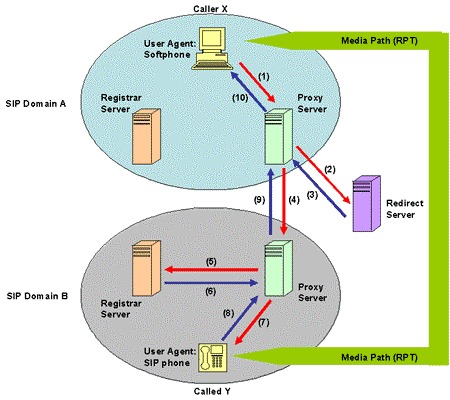You are here
How SIP enables VoIP
SIP enables the VoIP (Voice over IP) industry to produce inter-operable telephony products. Customers can now use an IP PBX from one vendor, a media gateway from another, and a phone from a third vendor. SIP is fast replacing H.323 in VoIP.
SIP uses session description protocol (SDP) as a media description language and RTP / RTCP as a real time transport protocol for media. SIP User Agents (UA) take the role of end points; the Proxy, Registrar and Redirect servers take the roles of network management, addressing resolution, authentication, and authorization.
How does this work?
The primary role of SIP is to allow the caller and the called party to contact each other, to set up, modify, and finally end various types of communication sessions like voice calls and video conferencing. The protocol components mentioned above together deliver messages embedded with the SDP protocol, defining their content and characteristics, to complete a SIP session.
The accompanying figure shows very simply how some of these SIP logical entities use messages to interact - in this case to set up a voice call from a PC (soft phone) to (hardware) SIP VOIP phone .

Figure 1. SIP Session in dissimilar Domains (www.lightreading.com)
The message and action sequence for establishing a SIP session in dissimilar domains is explained below. The following numbered points explain the red and blue arrows in the figure.
- User X in Domain A calls User Y in Domain B
- Query of Proxy server in Domain A: 'How to get to User Y in Domain B'
(Here the SIP Proxy Server of Domain A recognizes that the User Y is outside the Domain A and queries the SIP Redirect Server for User Y's IP address.) - Redirect Server's response: 'Address is enclosed in the response message, send the requests to Proxy Server in Domain B'.
- Call Proxied to SIP Proxy Server of Domain B.(SIP Proxy Server A forwards the SIP session invitation to SIP Proxy Server B)
- Proxy Server B's query: 'Where is User Y?'
- Registrar Server B's response: 'User Y is at the address enclosed in this response message.'
- Proxy server B delivers User X's invitation to User Y.
- User Y's response. User Y responds to User X's call.
- Response. Proxy server of User Y sends the response of User Y to Proxy server of User X.
- Response. Proxy server of User X conveys User Y's response to User X. (User Y forwards his or her acceptance along the same path the invitation travelled.)
If the call set-up is successful (Y is free to take the call), a media path using RPT is established between X and Y and the connected parties can start to talk.
